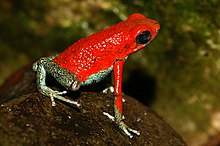aposematism
Appearance
English
[edit]Etymology
[edit]
apo- (prefix meaning ‘away from’) (from Ancient Greek ᾰ̓πό (ăpó, “from, away from”)) + semat(ic) (“acting as a sign of danger”) (from Ancient Greek σῆμα (sêma, “mark, sign, token”),[1] from Proto-Indo-European *dʰyeh₂- (“to notice”) + -μᾰ (-mă, suffix forming neuter nouns denoting the object or result of an action, or a particular instance of an action)) + -ism. The word aposematic was coined by British evolutionary biologist Edward Bagnall Poulton (1856–1943) in The Colours of Animals (1890).[2]
Pronunciation
[edit]- (Received Pronunciation) IPA(key): /ˌæpə(ʊ)sɪˈmætɪz(ə)m/
Audio (Southern England): (file)
- (General American) IPA(key): /ˌæpoʊsɪˈmætɪz(ə)m/, /-pə-/, [-ɾɪ-]
- Hyphenation: apo‧se‧mat‧i‧sm
Noun
[edit]aposematism (plural aposematisms)
- (biology, chiefly zoology) An adaptation, especially a form of coloration, that warns off potential predators.
- 1954, Zoologica: Scientific Contributions of the New York Zoological Society, New York, N.Y.: New York Zoological Society, →OCLC, page 193, column 1:
- First, the selection of "red" as a releaser in courtship and social chasing indicates a secondarily evolved use of aposematic coloring. It is assumed here that aposematism in this and other red-and-black heliconiids, and their correlated development of Müllerian mimicry, occurred in evolution before the development of red as a social releaser.
- 1990 June, Mary [K.] Wicksten, compiler, Adaptive Coloration in Invertebrates: Proceedings of a Symposium Sponsored by the American Society of Zoologists (TAMU-SG; 90-106), [Galveston, Tex.]: Texas A&M Sea Grant College Program, →OCLC, page 77, column 1:
- The co-occurrence of conspicuous coloration and noxious characteristics in many coastal marine species suggests that aposematism is a common predator deterrent in the marine environment.
- 2008, J. M. Jeshke, C. Laforsch, R. Tollrian, “Animal Prey Defenses”, in Encyclopedia of Ecology, volumes 1 (A–C), Amsterdam: Elsevier, →ISBN, page 191, column 2:
- Detected prey can avoid an attack by way of warning signals (aposematism), for example, bright coloration as a sign of toxicity. […] Aposematisms offer opportunities for 'cheating' species which are not poisonous but show the same color pattern, so-called Batesian mimicry.
- 2015 June, Lina María Arenas, Dominic Walter, Martin Stevens, “Signal Honesty and Predation Risk among a Closely Related Group of Aposematic Species”, in Nature[1], volume 5, London: Nature Research, , →ISSN, →OCLC, archived from the original on 18 September 2015, article number 11021:
- For example, both toxicity and coloration may be energetically costly to produce and maintain, and some theoretical models have predicted that once a predator has learned that a prey is toxic, prey should reduce the amount of energy invested in producing an honest signal. This could in turn make aposematism evolutionarily stable, as opposed to a constant arms race between toxicity, coloration and predator perception or toxic resistance
- 2018, Graeme D. Ruxton, William L. Allen, Thomas N. Sherratt, Michael P. Speed, “Aposematism”, in Avoiding Attack: The Evolutionary Ecology of Crypsis, Aposematism, and Mimicry, 2nd edition, Oxford: Oxford University Press, , →ISBN, section 6.2.6 (Aposematism is Primarily a Phenomenon in Animals, but It may be Present in Other Groups), pages 89–90:
- We focus in this text on animal defences, but aposematism may apply in other groups. Aposematism has thus been variously proposed in plants […] where, for example, conspicuous coloration on the tips of defensitve spines might serve to draw the attention of predators and deter them from attacking. It has been suggested also that aposematism exists in some fungi […]
Hyponyms
[edit]Related terms
[edit]Translations
[edit]adaptation that warns off potential predators
|
References
[edit]- ^ Compare “aposematic, adj.”, in OED Online
 , Oxford: Oxford University Press, 1933; “aposematic”, in Lexico, Dictionary.com; Oxford University Press, 2019–2022.
, Oxford: Oxford University Press, 1933; “aposematic”, in Lexico, Dictionary.com; Oxford University Press, 2019–2022.
- ^ See, for example, Edward Bagnall Poulton (1890) “Summary and Classification”, in The Colours of Animals: Their Meaning and Use: Especially Considered in the Case of Insects (International Scientific Series; 68), London: Kegan Paul, Trench, Trübner, & Co., →OCLC, page 337: “The second head (Sematic Colours) includes Warning Colours and Recognition Markings: the former warn an enemy off, and are therefore called Aposematic; […]”. Poulton noted at page 336: “My friend Mr. Arthur Sidgwick has kindly helped me in choosing the words.”
Further reading
[edit] aposematism on Wikipedia.Wikipedia
aposematism on Wikipedia.Wikipedia
Categories:
- English terms derived from Proto-Indo-European
- English terms derived from the Proto-Indo-European root *dʰyeh₂-
- English terms derived from Ancient Greek
- English terms suffixed with -ism
- English 6-syllable words
- English terms with IPA pronunciation
- English terms with audio pronunciation
- English lemmas
- English nouns
- English countable nouns
- en:Biology
- en:Zoology
- English terms with quotations
- English terms prefixed with apo-
